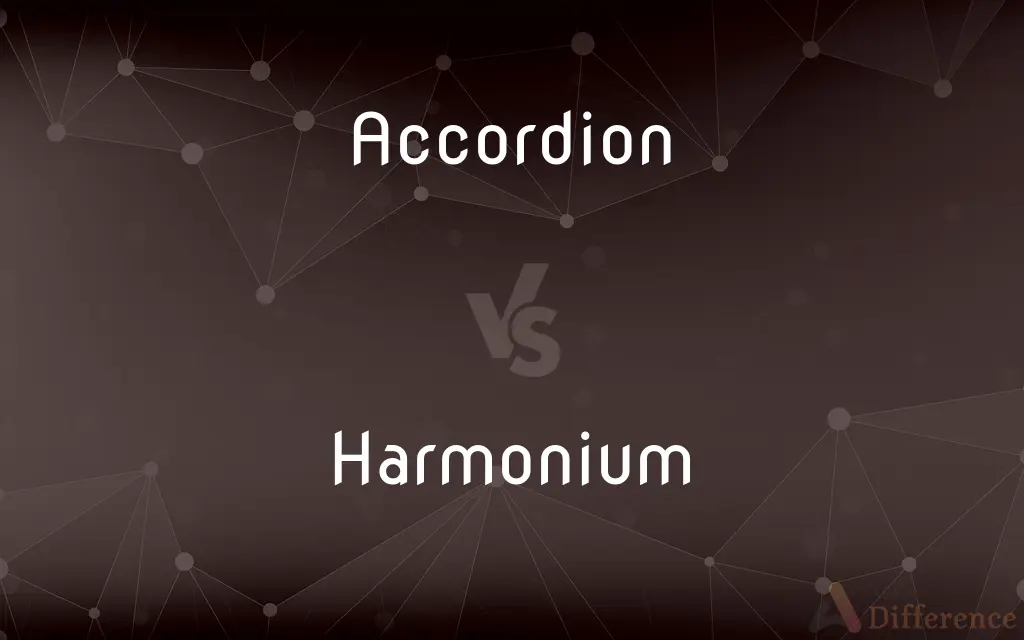Accordion vs. Harmonium — What's the Difference?
By Tayyaba Rehman & Maham Liaqat — Updated on March 28, 2024
Accordion produces sound by air blown over reeds from bellows, offering a wide range of tones; harmonium, played similarly, uses hand-pumped bellows to blow air through reeds for a sustained, organ-like sound.

Difference Between Accordion and Harmonium
Table of Contents
ADVERTISEMENT
Key Differences
The accordion is a versatile, portable instrument known for its use in various music genres worldwide, utilizing a bellows mechanism to force air over reeds, producing sound. Whereas the harmonium, originating from the free-reed family like the accordion, is primarily used in Indian classical music and often found in worship settings, producing sound by pumping air through reeds with hand-operated bellows.
Both instruments have keyboards, but the accordion includes a set of bass buttons on the left-hand side, enabling the player to play bass lines and chords. On the other hand, the harmonium typically features a set of stops or knobs that control the flow of air to the reeds, allowing for variations in volume and tone but lacks the bass accompaniment capability.
The accordion's sound is dynamic and can be varied by the force with which the bellows are operated, making it suitable for a wide range of musical expressions, from folk to classical. The harmonium, however, offers a more consistent, sustained tone, preferred in settings where a steady accompaniment is needed, such as vocal music.
In terms of construction, accordions are built with a complex mechanism of buttons or keys, reeds, and bellows, designed for both melody and harmony. Harmoniums, while also complex, are more focused on producing a rich, organ-like sound and may have fewer keys than a typical accordion.
Culturally, the accordion is associated with many traditions and is integral to the folk music of regions like Europe, North and South America. The harmonium has a strong connection to South Asian music, particularly in religious and classical performances, highlighting its cultural significance in these areas.
ADVERTISEMENT
Comparison Chart
Origin
Europe, 19th century
Europe, 19th century; popularized in India
Sound Production
Air forced over reeds by bellows
Air pumped through reeds by hand-operated bellows
Musical Range
Wide, capable of melody and harmony
More limited, typically used for sustained accompaniment
Use Case
Versatile, used in folk, classical, and popular music
Primarily in Indian classical music and spiritual songs
Physical Characteristics
Portable, with piano or button keys and bass buttons
Usually larger, with a keyboard and stops but no bass side
Compare with Definitions
Accordion
Often used in a variety of musical genres, from classical to pop.
He incorporated the accordion into his pop music composition.
Harmonium
Lacks the bass and chord buttons found on accordions, focusing on melody.
Unlike the accordion, the harmonium is played with only the right hand on the keys.
Accordion
A musical instrument with a series of buttons or keys, played by opening and closing a bellows.
She played a lively polka on the accordion.
Harmonium
A keyboard instrument with reeds, played by pumping air through the reeds with bellows.
The harmonium's drone accompanied the evening prayer.
Accordion
Characterized by its distinct, rich sound capable of both melody and harmony.
The accordion filled the room with its melodious harmony.
Harmonium
Features stops to control the flow of air to the reeds, affecting volume and tone.
Adjusting the harmonium's stops, he fine-tuned the sound for the concert.
Accordion
Known for its complex mechanism of reeds, bellows, and keys/buttons.
Repairing an accordion requires understanding its intricate design.
Harmonium
Produces a sustained, organ-like sound, ideal for vocal accompaniment.
Her voice was beautifully supported by the harmonium's steady tone.
Accordion
A portable, free-reed instrument offering a wide range of musical expressions.
The accordion's versatility makes it popular in folk music.
Harmonium
Commonly used in Indian classical music and spiritual songs.
The harmonium player led the group in a classical raga.
Accordion
Accordions (from 19th-century German Akkordeon, from Akkord—"musical chord, concord of sounds") are a family of box-shaped musical instruments of the bellows-driven free-reed aerophone type, colloquially referred to as a squeezebox. A person who plays the accordion is called an accordionist.
Harmonium
A keyboard instrument in which the notes are produced by air driven through metal reeds by foot-operated bellows.
Accordion
A musical instrument played by stretching and squeezing with the hands to work a central bellows that blows air over metal reeds, the melody and chords being sounded by buttons or keys.
Her five brothers and sisters were singing to the accompaniment of an accordion
An accordion player
Harmonium
An organlike keyboard instrument that produces tones with free metal reeds actuated by air forced from a bellows.
Accordion
A portable wind instrument with a small keyboard and free metal reeds that sound when air is forced past them by pleated bellows operated by the player.
Harmonium
(music) A small keyboard instrument that consists of a series of reed pipes, which sound when one of the keys is pressed to open a valve that allows air to pass through.
Accordion
Having folds or bends like the bellows of an accordion
Accordion pleats.
Accordion blinds.
Harmonium
A musical instrument, resembling a small organ and especially designed for church music, in which the tones are produced by forcing air by means of a bellows so as to cause the vibration of free metallic reeds. It is now made with one or two keyboards, and has pedals and stops.
Accordion
A box-shaped musical instrument with means of keys and buttons, whose tones are generated by play of the wind from a squeezed bellows upon free metallic reeds.
Harmonium
A free-reed instrument in which air is forced through the reeds by bellows
Accordion
(GUI) A vertical list of items that can be individually expanded and collapsed to reveal their contents.
Accordion
(figurative) A set of items (concepts, links, or otherwise) that can be packed and unpacked cognitively, or their representation as a set of virtual object. en
Accordion
To fold up, in the manner of an accordion
Accordion
A small, portable, keyed wind instrument, whose tones are generated by play of the wind upon free metallic reeds.
Accordion
A portable box-shaped free-reed instrument; the reeds are made to vibrate by air from the bellows controlled by the player
Accordion
Arranged in parallel folds;
Plicate leaves
Common Curiosities
Can the accordion be used in classical music?
Yes, the accordion's wide range and expressive capabilities make it suitable for classical music.
Are there different types of accordions?
Yes, there are several types, including piano and button accordions, each with unique layouts and sounds.
Is the harmonium easy to transport?
While more portable than a piano, harmoniums can be bulky and less mobile than accordions.
Can you play chords on a harmonium?
Yes, chords can be played on a harmonium, though it's primarily used for melody and accompaniment.
Can the harmonium be used in Western music?
Yes, though less common, the harmonium can be adapted for use in Western music, especially in ambient and experimental genres.
How do you maintain an accordion?
Regular maintenance includes checking the bellows, reeds, and keys, and keeping the instrument in a dry, stable environment.
What's the best setting to use a harmonium?
The harmonium shines in settings requiring sustained tones, like vocal accompaniment in Indian classical music or spiritual songs.
Do both instruments use the same method to produce sound?
Both use air pushed over reeds to produce sound, but their mechanisms for air flow and control differ.
Is it harder to learn to play the accordion or the harmonium?
Difficulty is subjective and depends on the player's musical background, but accordions may present more complexity due to their bass side.
How do you maintain a harmonium?
Maintenance involves regular cleaning, tuning the reeds, and ensuring the bellows operate smoothly.
Can the harmonium produce dynamics similar to the accordion?
The harmonium can produce dynamics through bellows control, but its range is more limited than the accordion's.
Are accordions more expensive than harmoniums?
Prices vary widely based on brand, quality, and type, but accordions can be more expensive due to their complex mechanism.
Can accordions be electronic?
Yes, there are electronic accordions that mimic traditional sounds or produce synthesized tones.
Why is the accordion popular in folk music?
Its portability, expressive range, and ability to produce both melody and harmony make it ideal for folk music traditions worldwide.
Do both instruments have a keyboard?
Yes, both have keyboards, but the accordion also has bass buttons for additional harmonic support.
Share Your Discovery

Previous Comparison
Notepad vs. Notebook
Next Comparison
Aggregate vs. BallastAuthor Spotlight
Written by
Tayyaba RehmanTayyaba Rehman is a distinguished writer, currently serving as a primary contributor to askdifference.com. As a researcher in semantics and etymology, Tayyaba's passion for the complexity of languages and their distinctions has found a perfect home on the platform. Tayyaba delves into the intricacies of language, distinguishing between commonly confused words and phrases, thereby providing clarity for readers worldwide.
Co-written by
Maham Liaqat















































